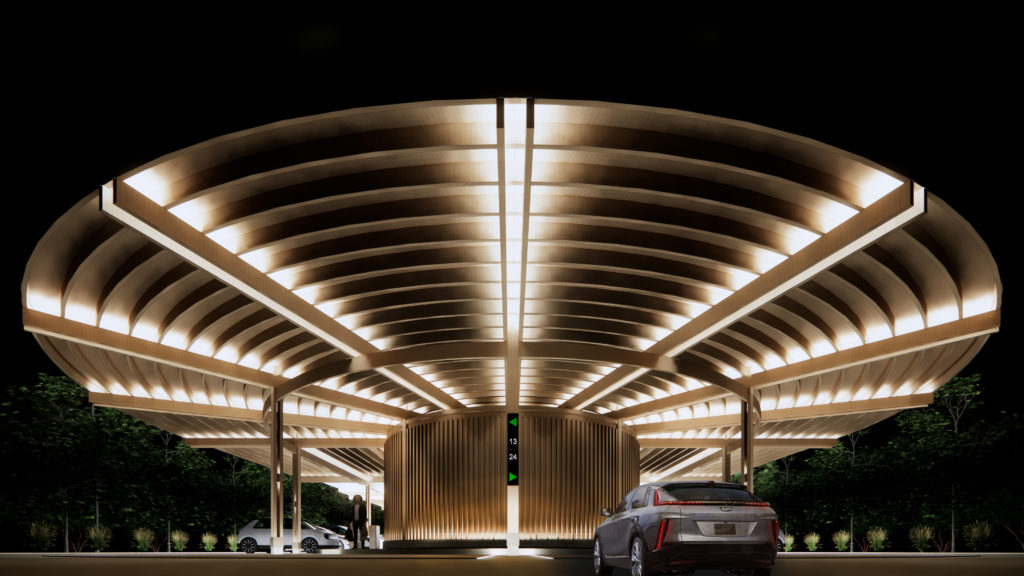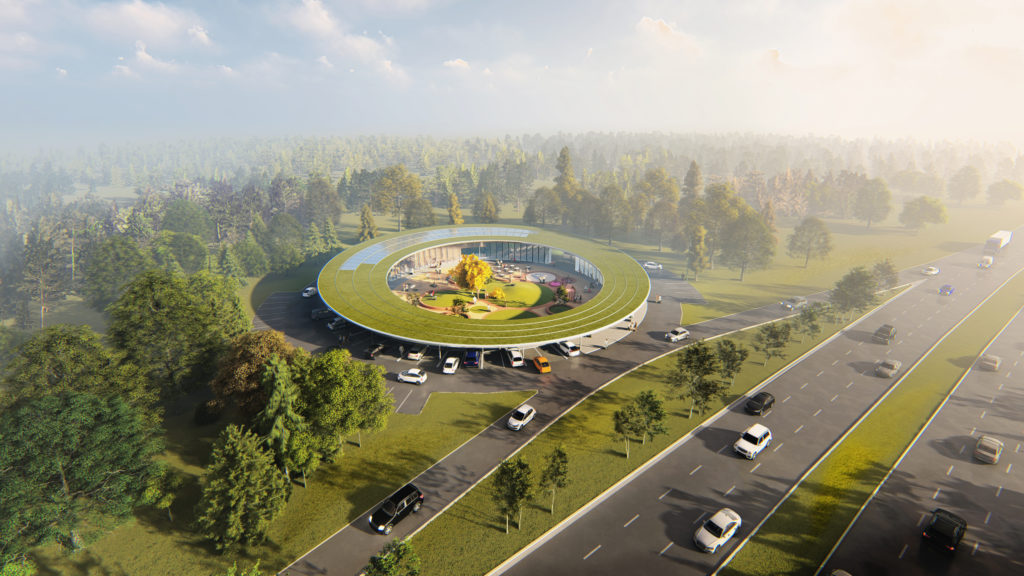After nine hours on the road, the travelers needed a rest, and so did their car. Even with its EVercorp® quadruple-isomer batteries, equipped with TruBoost® converters, the vehicle’s power gauge was slipping into the red zone, indicating the need for a full recharge. Luckily, just over the next rise, the family spied an Oasisphere Way-Station. Each family member anticipated the wonders of the modern EV station: five-star dining, live entertainment, a luxurious hyperspa. And, of course, electricity for the car — ostensibly the whole point of the stop.
The technology may be futuristic — just a bit beyond the temporal horizon, when fleets of affordable, efficient electric cars will usher in a new era of carbon-free road-tripping. But the experience of travel by electric vehicle will likely include an element predating the automobile era. From caravans stopping for the night at a villa on a Roman road, to a stagecoach swapping horses at a remote Wild West outpost, to a tourist on the European “Grand Tour” awaiting a transfer in the halls of a classic railway station, long journeys have always included layovers and pit stops. Thanks to the way electric vehicles work, we may soon breathe fresh life into a once-rich aspect of travel: the way station.
None of us remember it now, but when people started driving gas-powered cars, they needed to develop an entire system to keep them fueled as they rolled merrily along. The Model T got surprisingly good gas mileage — about 21 miles per gallon — but gas stations were much less common, and travelers needed to plan carefully for long trips to make sure they wouldn’t run out of fuel between stops. Today, the same holds true for those EV early-adopters, with one important difference: while a conventional gas tank can be refilled in a matter of minutes, recharging your electric car can take anywhere from a half hour for a quick top-off (just enough to get you another 50 miles after running some errands), to overnight for a full charge.
Today, only about 2.3 million electric vehicles are on the road in the U.S. — just under 1% of the cars and trucks out there. But this figure is climbing rapidly, due to generous tax credits, better batteries, higher gas prices, regulatory quotas, and changing consumer demands. Advocates are hoping that by 2035, over half of new vehicle sales will be electric, and that by 2050, EVs will make up as much as 60% to 70% of vehicles on the road.
After driving 300 to 350 miles — a relatively short leg on most modern cross-country road trips — even today’s latest high-capacity batteries will require a complete recharge, taking five to seven hours or longer. For now, these prolonged pit stops may be an inconvenience, but through some creative thinking they might nurture a revitalized type of development that looks far different than today’s highway “rest stops.”
Already, it’s beginning: In Yokohama, Japan, the high-tech Innergie Café offers coffee, entertainment, and EV charging in what was once a Shell gas station — a signature decaf espresso macchiato with a twist of irony.
Planners in Europe, where electric vehicles are already in wider use, have long organized cities and transportation around shared hubs.
The program envisions replacing gas stations with a variety of “new-age community centers,” including “The Zone” (relaxation spas, yoga studios, enigmatic-but-intriguing “Zen pods”), “The Booster” (a “productivity hub”), and “The Clubhouse” (a “unique urban destination” for communal socializing).
In the U.S., Disney offers EV charging at all its theme parks and resorts, with coveted prime spots close to the entry gates. The National Park Service has a growing network of chargers at or near parks from Yosemite and Yellowstone to the Everglades and Cape Cod National Seashore. An ax-throwing bar and amusement center in downtown Milwaukee offers valet parking and charging for electric vehicles, and the owners have agreed to leave the power on for free when the bar is closed.
But some companies and technologists are envisioning something much broader: making charging stations destinations in themselves. A collaboration of futurists at BMW Designworks and the design and architecture firm Gensler, known collectively as “Architecture X Mobility,” has launched an ambitious pilot project and design manifesto, intended to blur the boundaries between vehicle, habitation, and public space.
Central to the effort would be the creation of what the group calls “Nth Spaces” — neither home nor work, but something in between and more — promoting “mindfulness, social interactions, or work, with vehicle charging serving as a secondary function.” Still in the conceptual stages, the program envisions replacing gas stations with a variety of “new-age community centers,” including “The Zone” (relaxation spas, yoga studios, enigmatic-but-intriguing “Zen pods”), “The Booster” (a “productivity hub”), and “The Clubhouse” (a “unique urban destination” for communal socializing).
In Canada, a consortium of industry partners recently sponsored a competition to design the “Electric Fuelling Station of the Future,” challenging architects and designers to “reimagine the highway gas station of today as a new roadside oasis for electric vehicles.” The brief for the competition asks, “How can we recharge not just our cars, but also ourselves at the same time?” The entries include over 100 thought-provoking ideas and stunning visual renderings from around the world, combining EV charging stations with playgrounds, flexible workspaces, libraries, game rooms, and even robotic restaurants (with “smart furniture robo-modules” capable of “delivering food on demand”).
The winning entry, by Scottish architect James Silvester, proposes “more with less,” combining a clean solar charging station with warm, sustainable timber framing LED-lit lounges and plant-filled courtyards. The concept is minimalist, but the contrast with the carbon-and-steel, gas-pumping rest stop of today is striking: “a radical change from gas stations as we know them,” in the words of one of the judges.





Several notable designs highlight opportunities for mixing and social interaction, including the second-place winner by Turkish architects Fabric.a, proposing a bold EV station with play areas and dining spaces under a green canopy. As described by the team, “The Circle” provides “a vibrant meeting point for electric vehicle owners.” Other entries play up the potential to integrate EV charging with beautiful and healthy natural surroundings, providing charging stations in nature preserves, dog parks, jogging and cycling tracks, and even sledding hills.



Though many ideas for EV charging stations emphasize shared spaces and communal interaction, other likely paths could lead us to a future of exclusion, separating the EV haves and have-nots. Rather than a seamless network of uniformly high-quality way stations, some routes or regions may attract the latest high-tech offerings, with others relegated to an EV backwater, with fewer, less desirable options — or none, like today’s food deserts or cellular dead zones. Stations might offer better services and amenities for some “classes” of users, like airports’ high-touch luxury lounges for business travelers or exclusive club members, while the rest of us crowd into uncomfortable chairs with blaring TVs and bad food options. And, like today, divides by income could line up with existing racial and ethnic disparities.
Or it’s also possible — as with any predictions about technology — that some new innovation, from better batteries to alternate fuel cells, could relegate the emerging EV way station to some cul-de-sac of history, replaced by “the next big thing” before it even gets off the ground. But for now, it’s fun to dream a bit and plan the future road trip.
Published on



